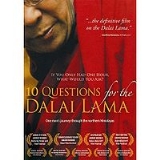
10 Questions for the Dalai Lama
Encyclopedia
10 Questions For The Dalai Lama is a 2006 documentary film in which filmmaker Rick Ray
meets with Tenzin Gyatso, the 14th Dalai Lama
at his monastery in Dharamsala
, India
. The film maker asks him ten questions during the course of the interview which is inter-cut with a biography of Tenzin Gyatso, a history of modern Tibet
and a chronicle of Ray's journey securing the interview.
to interview Tenzin Gyatso. The film switches between present and recent past, with stages of the trip introducing sections on the personal history of Tenzin Gyatso, the process used to select a Dalai Lama
and Gyatso's journey into exile.
The interview with Tenzin Gyatso begins midway through the film. This section is inter-cut between sections addressing philosophical questions and current affairs.
The film also features the daily life of Tenzin Gyatso, his international peace efforts and his work with Tibetan refugees.
The film features interviews with a Buddhist monk who fled violence in Tibet
and Tenzin Tethong, who has served in the Tibetan Government in Exile for 20 years.
Towards the end, the film touches on the issues of internet censorship
in China, changes in Tibetan culture, and the 11th Panchen Lama
controversy.
Some of the questions asked:
The questions are not numbered in the film and Ray admits to asking more than ten questions during the interview.
Rick Ray
Rick Ray is an American filmmaker best known for his 2006 documentary film 10 Questions for the Dalai Lama which he wrote, filmed and directed. His documentary Lynching Charlie Lynch, about the trials of former medical marijuana dispensary owner Charles C...
meets with Tenzin Gyatso, the 14th Dalai Lama
Dalai Lama
The Dalai Lama is a high lama in the Gelug or "Yellow Hat" branch of Tibetan Buddhism. The name is a combination of the Mongolian word далай meaning "Ocean" and the Tibetan word bla-ma meaning "teacher"...
at his monastery in Dharamsala
Dharamsala
Dharamshala or Dharamsala is a city in northern India. It was formerly known as Bhagsu; it is the winter seat of government of the state of Himachal Pradesh and the district headquarters of the Kangra district....
, India
India
India , officially the Republic of India , is a country in South Asia. It is the seventh-largest country by geographical area, the second-most populous country with over 1.2 billion people, and the most populous democracy in the world...
. The film maker asks him ten questions during the course of the interview which is inter-cut with a biography of Tenzin Gyatso, a history of modern Tibet
Tibet
Tibet is a plateau region in Asia, north-east of the Himalayas. It is the traditional homeland of the Tibetan people as well as some other ethnic groups such as Monpas, Qiang, and Lhobas, and is now also inhabited by considerable numbers of Han and Hui people...
and a chronicle of Ray's journey securing the interview.
Synopsis
The film begins as a chronicle of Rick Ray's journey through IndiaIndia
India , officially the Republic of India , is a country in South Asia. It is the seventh-largest country by geographical area, the second-most populous country with over 1.2 billion people, and the most populous democracy in the world...
to interview Tenzin Gyatso. The film switches between present and recent past, with stages of the trip introducing sections on the personal history of Tenzin Gyatso, the process used to select a Dalai Lama
Dalai Lama
The Dalai Lama is a high lama in the Gelug or "Yellow Hat" branch of Tibetan Buddhism. The name is a combination of the Mongolian word далай meaning "Ocean" and the Tibetan word bla-ma meaning "teacher"...
and Gyatso's journey into exile.
The interview with Tenzin Gyatso begins midway through the film. This section is inter-cut between sections addressing philosophical questions and current affairs.
The film also features the daily life of Tenzin Gyatso, his international peace efforts and his work with Tibetan refugees.
The film features interviews with a Buddhist monk who fled violence in Tibet
Tibet
Tibet is a plateau region in Asia, north-east of the Himalayas. It is the traditional homeland of the Tibetan people as well as some other ethnic groups such as Monpas, Qiang, and Lhobas, and is now also inhabited by considerable numbers of Han and Hui people...
and Tenzin Tethong, who has served in the Tibetan Government in Exile for 20 years.
Towards the end, the film touches on the issues of internet censorship
Internet censorship
Internet censorship is the control or suppression of the publishing of, or access to information on the Internet. It may be carried out by governments or by private organizations either at the behest of government or on their own initiative...
in China, changes in Tibetan culture, and the 11th Panchen Lama
11th Panchen Lama
The 11th Panchen Lama controversy is a dispute about the current legitimate holder of the Panchen Lama title, a political and religious leadership position in Tibet and Tibetan Buddhism. After the death of the 10th Panchen Lama, a dispute between the Chinese leadership and the exiled 14th Dalai...
controversy.
The interview
Ray asks a range of questions, touching on philosophical, social and political issues.Some of the questions asked:
- "Why do the poor seem happier than the rich?"
- "How can one reconcile an attitude of non-violence when faced with a direct threat to one's safety and security?"
- "Should countries be dedicated to preserving their traditions or embrace modern culture?"
- "Will there be another Dalai Lama?"
The questions are not numbered in the film and Ray admits to asking more than ten questions during the interview.

